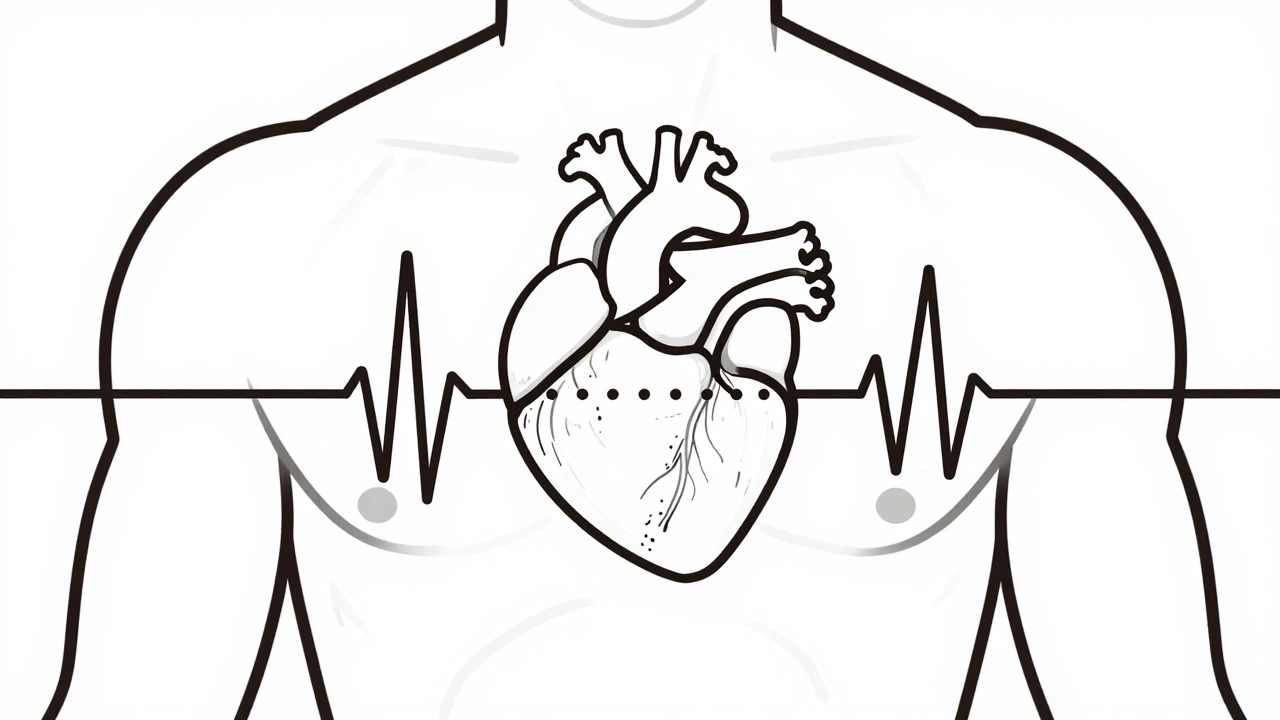Atrial fibrillation: What it looks like and what to do
Atrial fibrillation (AF) is a fast, irregular heartbeat that feels like fluttering, racing, or skipped beats. People notice palpitations, breathlessness, chest discomfort, lightheadedness, or extreme tiredness. Some have no symptoms and only find AF during a routine exam. If you feel sudden, prolonged palpitations or fainting, seek care right away.
Tests and treatment options
Diagnosis starts with a simple ECG in the clinic or emergency room. If the ECG is normal but symptoms continue, doctors often use a Holter monitor (24–48 hours) or an event monitor for longer tracking. An echocardiogram looks for heart structure problems, and basic blood tests check thyroid function and electrolytes.
Treatment has two main goals: lower stroke risk and control the heart rhythm or rate. Stroke prevention usually means anticoagulation. Common options are warfarin or direct oral anticoagulants (DOACs) such as apixaban, rivaroxaban, dabigatran, and edoxaban. DOACs need less monitoring than warfarin but still carry bleeding risk—talk to your clinician about which fits you.
For symptoms, doctors choose rate control (beta-blockers, calcium-channel blockers, digoxin) or rhythm control (antiarrhythmic drugs like flecainide or amiodarone, electrical cardioversion). If medications don’t help, catheter ablation can isolate triggers in the heart and often reduces symptoms. Your doctor will weigh risks, age, other illnesses, and personal priorities when picking a plan.
Everyday steps to lower risk
Control blood pressure and diabetes—those two lower your stroke and AF complications. Treat sleep apnea if you snore and feel very sleepy during the day; fixing sleep apnea often improves AF. Cut back on heavy alcohol drinking and avoid stimulant overuse (some cough medicines, high-dose caffeine). Stay active with regular, moderate exercise and keep a healthy weight.
Keep a simple symptom log: note when palpitations start, what you were doing, how long they lasted, and any other symptoms. Bring that to appointments—it helps decide whether you need a longer monitor or changes in therapy. Also, list all medicines and supplements; some interact with anticoagulants or trigger arrhythmias.
Red flags: call emergency services for chest pain, severe shortness of breath, fainting, or confusion. For ongoing care, expect regular follow-ups to check blood tests, medication side effects, and stroke risk using scores like CHA2DS2-VASc and bleeding risk assessments.
Modern tools help. Many people now spot irregular pulses on smartwatches or fitness trackers. Those devices aren't perfect but they can prompt an earlier visit. If you're on a DOAC and face serious bleeding or urgent surgery, doctors can use reversal agents — idarucizumab for dabigatran and andexanet alfa for rivaroxaban or apixaban. Always carry an up-to-date medication list and emergency contact.
If you're pregnant or planning pregnancy, talk to a cardiologist and obstetrician. AF treatment during pregnancy needs expert care because some drugs aren't safe. Younger people with lone AF still need risk assessment; age and other conditions change treatment. Don't delay getting a specialist opinion if treatment feels unclear.
AF is manageable for most people. With the right medicines, lifestyle steps, and follow-up, you can reduce stroke risk and often get symptoms under control. Talk openly with your clinician about your goals—living well matters as much as treating numbers.
- Colin Hurd
- Dec, 8 2025
- 12 Comments
Arrhythmias Explained: Atrial Fibrillation, Bradycardia, and Tachycardia
Learn about atrial fibrillation, bradycardia, and tachycardia-three common heart rhythm disorders. Understand symptoms, diagnosis, treatments, and how to live well with them.
- Colin Hurd
- Jul, 31 2023
- 20 Comments
Atrial Fibrillation and Dementia: Exploring the Link
Alright, folks! Let's dive into this heart-pounding, mind-boggling topic: Atrial Fibrillation (AFib) and Dementia. Now, hold onto your hats because there seems to be a connection between these two! Studies suggest that AFib, which makes your heart skip like a teenager in love, may increase the risk of dementia, a condition that tends to play hide-and-seek with your memory. The science behind this? Well, it's as tangled as a spaghetti junction, but it has something to do with how AFib can affect blood flow to the brain, like a badly directed traffic. So, it's like a double whammy, a two-for-one deal nobody wants, but don't worry, researchers are on it like white on rice!

